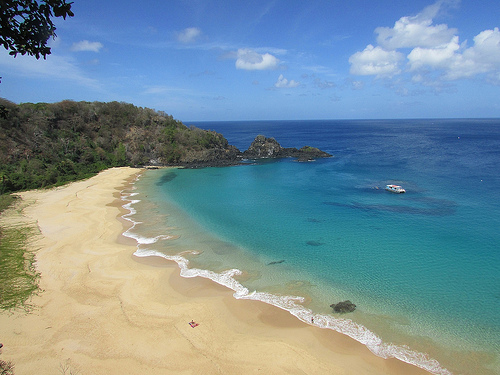Lots of little islands in Fernando de Noronha.
- Fernando de Noronha is a tropical island archipelago consisting of 21 islands located near the coast of South America’s Brazil in the Atlantic Ocean.
- ‘Fernando de Noronha’ is named after Portuguese Fernão de Loronha, a wood merchant from Lisbon, who is said to have funded and organised the expedition fleet that is believed to have discovered the islands in 1503, although there are accounts of possible earlier discoveries by other people.
- The total area of Fernando de Noronha is 26 square kilometres (10 square miles).
- Fernando de Noronha was listed as a UNESCO World Heritage Site in 2001 due to the importance of the islands’ ecosystem and their fauna and flora.
- The largest island, also called Fernando de Noronha, is 10 kilometres (6 miles) in length and 3.5 kilometres (2.2 miles) in width.
Fernando de Noronha
Image courtesy of Rosanetur/Flickr
- Fernando de Noronha was originally mostly forest, but it is said that is was cut down in the 1800s when prisoners were taken to the islands, and is now home to mostly schrubs and small forests.
- Fernando de Noronha is home to the largest population of dolphins in the world; a significant population of tropical seabirds; the endangered hawksbill turtle; numerous aquatic species; important plant species; and the endemic species of two birds, a dove and two reptiles.
- The Fernando de Noronha islands attract tourists, although visitors are limited, so as to not upset the fragile ecosystem.
- In 2012, the population of Fernando de Noronha was just over 2,700 people and the islands are accessed by plane or boat.
- Fernando de Noronha is popular among tourists for its beaches, diving, marine wildlife and fort ruins.
Bibliography:
Brazilian Atlantic Islands: Fernando de Noronha and Atol das Rocas Reserves, 2014, World Heritage Convention UNESCO, http://whc.unesco.org/en/list/1000
Fernando de Noronha, 2014, Wikipedia, http://en.wikipedia.org/wiki/Fernando_de_Noronha







nice information and beuatiful place